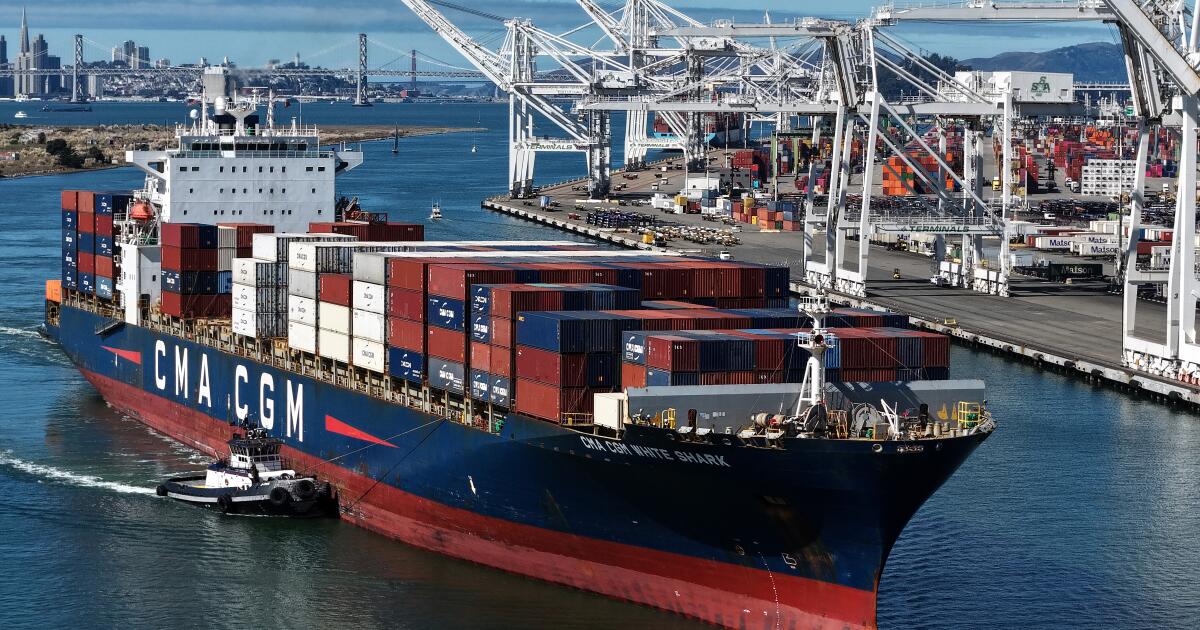Business
Tariffs Impact American Businesses, Driving Prices Higher

The introduction of new tariffs on furniture, timber, and lumber this week is exacerbating challenges for American businesses. While the White House maintains that these policies are centered on “fairness” and “reciprocity,” the reality reveals a different narrative, characterized by increased prices, declining profits, and a significant drop in exports across various industries.
American exports are facing a sharp decline, according to a recent survey by KPMG, which found that 60% of businesses reported decreased overseas sales in the first half of this year. Notably, U.S. liquor exports fell by 9% in the second quarter, particularly affecting sales in the European Union, Canada, Britain, and Japan—collectively responsible for around 70% of these exports. Similarly, U.S. soybean exports have plummeted by 23% this year, as China has shifted its sourcing to Argentina and other suppliers.
The impact is not limited to large corporations. A valve and gas-component manufacturer in Napa Valley recently announced a plant closure that will result in the loss of 237 jobs, citing reduced overseas demand linked to the tariffs. Furthermore, the upcoming Supreme Court case of V.O.S. Selections Inc. vs. Trump highlights the challenges faced by U.S. importers and resellers in sectors like wine and electronics, where tariffs have disrupted supply chains and forced significant price increases.
Consumers are feeling the strain as well. Nearly half of American companies surveyed by KPMG have raised prices due to tariffs, with two-thirds passing some of those costs onto customers. Approximately 40% of companies have paused hiring, while a third have implemented layoffs. Goldman Sachs estimates that U.S. consumers are now bearing 55% of the total tariff burden, with foreign exporters absorbing only a small fraction of the costs.
The situation is further complicated by new regulations concerning the documentation of imported goods. For instance, Krone, one of Europe’s largest farm-equipment manufacturers, has suspended U.S. sales because of stringent requirements related to tariffs on steel derivatives. This bureaucratic burden has led to delays and shortages of crucial harvesting equipment for American farmers.
Additionally, UPS has reported significant customs backlogs after the administration eliminated a long-standing provision that allowed imports under $800 to enter the U.S. duty-free. Thousands of packages, including items like Japanese tea and engagement rings, are stuck or have been disposed of due to missing tariff paperwork. This situation illustrates how protectionist measures can disrupt everyday commerce.
The impact of tariffs extends to common grocery items. Italian pasta makers have warned that tariffs approaching 92% could significantly increase the price of staples such as rigatoni, prompting Italian media to label it “Trump’s war against pasta.” There are also concerns that peanut butter could be affected by expanding steel and aluminum tariffs, with petitions requesting that food products packaged in metal be classified as “derivatives” subject to tariffs.
Business leaders are grappling with uncertainty as they anticipate upcoming tariffs on Chinese goods set to take effect on November 1, right before the holiday shopping season. Some companies are rushing to ship goods early, but even minor delays can severely impact their profit margins. The unpredictability surrounding deadlines and tariff announcements complicates long-term planning and investment strategies.
As the situation evolves, the broader economic picture appears troubling. Each new round of tariffs contributes to market volatility and increasing anxiety among investors regarding future White House actions. This has created a precarious environment characterized by rising prices, sluggish growth, and fears of stagflation. For the Treasury and the Federal Reserve, this landscape presents difficult choices regarding interest rates and the potential need for emergency measures to stabilize the financial system.
In summary, U.S. tariffs function as indirect taxes on American consumers. The resulting higher prices, diminished wages for factory workers, and increased global risks underscore a critical need for policy shifts. If the objective is to foster lower prices, boost investment, and create robust supply chains, the focus should be on establishing stable rules and open markets, rather than imposing higher tariff barriers.
This analysis is informed by insights from Veronique de Rugy, a senior research fellow at the Mercatus Center at George Mason University.
-

 Politics1 week ago
Politics1 week agoDallin H. Oaks Assumes Leadership of Latter-day Saints Church
-

 Sports1 week ago
Sports1 week agoSteve Kerr Supports Jonathan Kuminga After Ejection in Preseason Game
-

 Lifestyle1 week ago
Lifestyle1 week agoDua Lipa Celebrates Passing GCSE Spanish During World Tour
-

 Business1 week ago
Business1 week agoTyler Technologies Set to Reveal Q3 2025 Earnings on October 22
-

 Entertainment1 week ago
Entertainment1 week agoZoe Saldana Advocates for James Cameron’s Avatar Documentary
-

 Lifestyle1 week ago
Lifestyle1 week agoKelsea Ballerini Launches ‘Burn the Baggage’ Candle with Ranger Station
-

 Health1 week ago
Health1 week agoRichard Feldman Urges Ban on Menthol in Cigarettes and Vapes
-

 Health1 week ago
Health1 week agoCommunity Unites for Seventh Annual Mental Health Awareness Walk
-

 World1 week ago
World1 week agoD’Angelo, Iconic R&B Singer, Dies at 51 After Cancer Battle
-

 Science1 week ago
Science1 week agoChicago’s Viral ‘Rat Hole’ Likely Created by Squirrel, Study Reveals
-

 Business1 week ago
Business1 week agoMega Millions Jackpot Reaches $600 Million Ahead of Drawings
-

 Business1 week ago
Business1 week agoMLB Qualifying Offer Jumps to $22.02 Million for 2024









